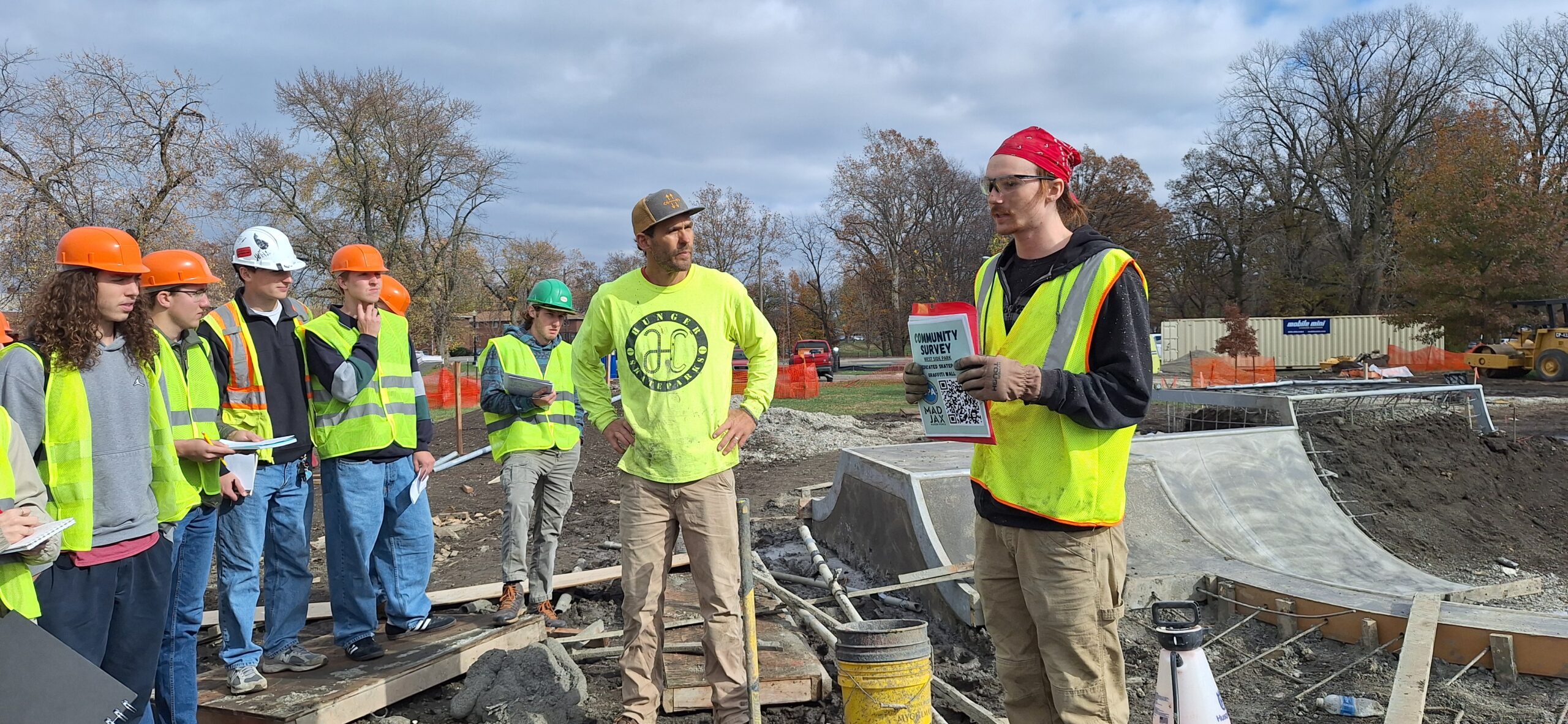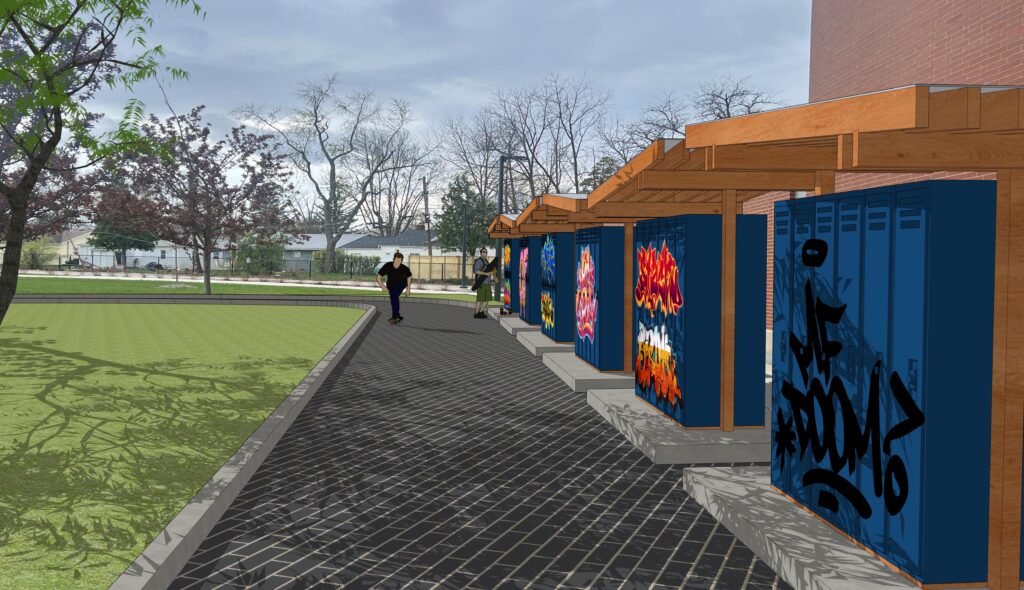In graffiti culture, a tag is the most basic unit of style—an artist’s signature or calling card, a way to mark territory and gain visibility in the urban landscape. Though often misunderstood as vandalism, tags can represent creativity, identity, and expression. For Caleb Swartz, a senior at Ball State University majoring in urban planning and development who grew up in Muncie, that raw form of expression has always intrigued him.
As a teenager, he noticed how few safe, accessible places existed for young people to express their creativity, and he began to envision what it would be like if the city embraced street art instead of marginalizing it.
When Muncie unveiled its West Side Skatepark on June 14, 2025, most of the attention was on the sleek concrete bowls and eager skaters. For Mr. Swartz, though, the opening also served as a reminder of the possibilities ahead: his proposal for a legal graffiti wall made from salvaged lockers.
“I wanted to create something I wished I had as a kid,” Mr. Swartz said. “A place where youth can explore identity and creativity without the risks of illegal tagging.”
That desire resonated widely. A community survey organized through the Ball State Student Planning Association, where Mr. Swartz serves as president, drew more than 200 responses. The results were striking: 96 percent of respondents supported the graffiti wall, and 85 percent believed it would reduce illegal tagging elsewhere in the park. The survey also revealed that 68 percent of respondents were current Ball State students, highlighting the project’s dual identity as both a city initiative and a campus-driven endeavor.
At the grand opening, Muncie’s mayor, Dan Ridenour, also publicly endorsed the graffiti wall, affirming the city’s commitment to blending recreation with creativity.
Collaboration Across Campus and Community
The project has drawn together a diverse coalition of partners. Hunger Skateparks, the company that built the park, has pledged construction assistance. MadJax Makers Force donated locker sections to serve as the canvas. Indiana Print Company collaborated with Mr. Swartz on a T-shirt fundraiser that raised nearly $500, matched by Ball State’s Estopinal College of Architecture and Planning (ECAP), hoping it would cover the initial installation costs.
Initial projections suggested that the project would need an additional $2,000 for installation—an amount Mr. Swartz was willing to contribute himself.
“Outside of our fundraising, we had a gap of about $2,000, which I was going to fund out of my pocket,” he said. “I am just that passionate about getting this project installed here in Muncie.”
Community engagement has been central to the process. Ball State students in landscape architecture visited the site during construction for hands-on learning. At the same time, the Student Planning Association hosted survey and fundraiser events on campus—painting lockers, selling shirts, and inviting peers to shape the project’s design. For Mr. Swartz, these events demonstrate the value of merging classroom learning with real-world planning.
“Ball State students aren’t just studying urban development—we’re actively contributing to Muncie’s future,” Mr. Swartz said.
Benefits for Muncie
Urban planners stress that energizing public spaces with art can transform communities. Survey analysis shows that residents believe the graffiti wall will help reduce vandalism at the skatepark by channeling creativity into a sanctioned space. They also see it as a way to promote safety and inclusivity through clear community guidelines, including PG-13 content, prohibitions on hate speech, and respect for others’ work. Beyond that, many expect it to build civic pride by turning the skatepark into a destination for art festivals, workshops, and youth mentorships.
The project also intends to nurture volunteerism—54 percent of survey respondents expressed willingness to help with installation or programming. This sets the stage for long-term stewardship. For Muncie, it’s a model of how public art can support cultural vibrancy while strengthening community ownership of shared spaces.
Despite overwhelming support, the project faces hurdles. The Muncie Parks Board recently requested an expansion of the wall, doubling its scale and raising installation costs to as much as $10,000. No longer able to fund that himself, Mr. Swartz is pursuing a grant from the George and Frances Ball Foundation with support from city and community partners. Permit requirements tied to nearby wetlands may delay the timeline until late 2026.
Beyond Graduation
Mr. Swartz, who will graduate from Ball State in December 2025, has spent the past year mobilizing campus and community resources to make this project a reality. While his professional future lies in Breckenridge, Colo.—where he recently secured a full-time planning position following a Summer internship—his roots in Muncie continue to shape his commitment to his hometown.
Although Mr. Swartz will soon relocate, he intends to remain closely involved. He plans to manage the grant application, continue partnership-building, and even explore documenting the wall’s use through data collection once installed. Inspired by international models and his work in Colorado, Mr. Swartz envisions a network of legal graffiti walls across U.S. skateparks—an ambitious goal rooted in the lessons learned at Ball State.
“I want to leave a lasting impression in Muncie,” he said. “I have made a lot of progress on this project, and I want to see it through. As a planner, I want to see this come to fruition in my hometown, track the data, and hopefully implement it in other communities.”


